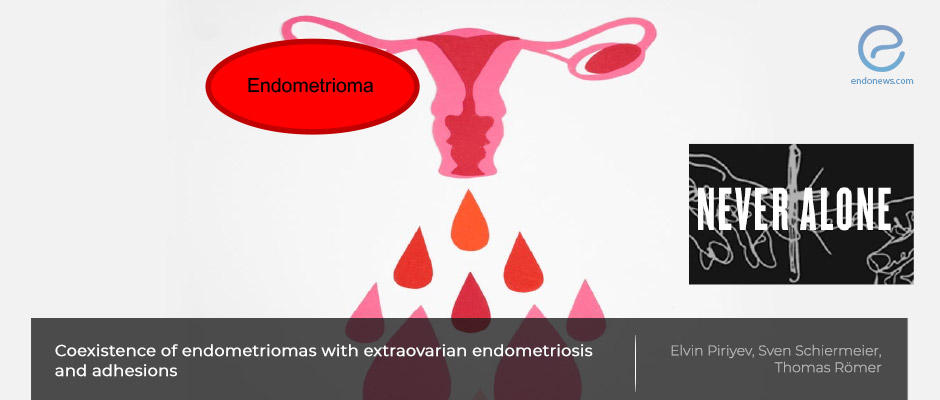It is not that simple: endometriomas are almost never alone
Aug 20, 2021
Endometrioma co-existence with peritoneal endometriosis, adhesions and deep infiltrating endometriosis
Key Points
Highlights:
- Endometriomas are usually coexisting with peritoneal endometriosis, adhesions, or deep infiltrating endometriosis, hence they should be managed by experienced surgeons.
Importance:
- The study highlights the importance of endometrioma surgeries, which should include a whole peritoneal examination to avoid missing concomitant lesions.
What's done here:
- The patient records between 2014 and 2019 were randomly chosen from Cologne Weyertal Academic Hospital have been included in the study.
- The size and laterality of histopathologically confirmed endometriomas, coexisting adhesions, and peritoneal or deep endometriotic lesions, history of previous abdominal surgeries have been recorded.
- The patients were grouped according to the ENZIAN endometrioma size definitions (<3cm, 3-7cm, and >7cm).
Key Results:
- Only 2.3% of all patients had endometriomas alone without adhesions, peritoneal endometriosis, or deep infiltrating endometriosis.
- 80.6% of all patients had concomitant peritoneal endometriosis, 43.2% had deep infiltrating endometriosis and 38% had both; with endometriomas.
- 14.2% of all analyzed patients did not have pathologically confirmed extra ovarian endometriosis but did have some adhesions.
- No relation was found between the incidence of peritoneal endometriosis and the size or laterality of endometriomas.
- Deep infiltrating endometriosis tend to be more common in patients with bilateral endometriomas.
- The Douglas obliteration and bilateral adhesion rates were higher in bilateral endometriomas, and the risk only increased by the size in case of unilateral endometriomas.
- The history of previous surgery increased the risk of adhesions.
Limitations:
- The study was conducted in a single center with a relatively limited number of patient records.
- The style of defining the peritoneal lesions and adhesions might change the results when it is conducted by different surgeons.
Lay Summary
Endometriomas are the widely and easily diagnosed type of endometriosis. They are usually treated by gynecologic surgeons and are thought to be alone most of the time.
The study conducted by Piriyev et al highlighted the coexistence of extraovarian endometriosis associated with endometriomas. The authors found only 2.3% of all endometriomas could be without any concomitant extraovarian endometriosis lesions.
While 80.6% of all patients had peritoneal endometriosis and 43.2% had deep infiltrating endometriosis, 38% of patients had both lesions together with endometriomas. Only 14.2% of all analyzed patients did not have pathologically confirmed extra ovarian endometriosis but they had intraperitoneal adhesions.
The authors were not able to find any relation between the incidence of peritoneal endometriosis and the size or laterality of endometriomas but deep infiltrating endometriosis tend to be more commonly present in patients with bilateral endometriomas. The Douglas obliteration and bilateral adhesion rates were higher in bilateral endometriomas, and the risk only increased by the size in case of unilateral endometriomas. Also, the history of previous surgery increased the risk of adhesions.
With all these findings, the authors suggested that endometriomas almost never occur without extraovarian endometriosis, and should always be operated on by experienced surgeons who are able to deal with other extraperitoneal lesions which would probably be lying side by side with the endometrioma.
Research Source: https://pubmed.ncbi.nlm.nih.gov/34144489/
endometrioma co-existence peritoneal endometriosis DIE adhesion bilateral advanced stage

